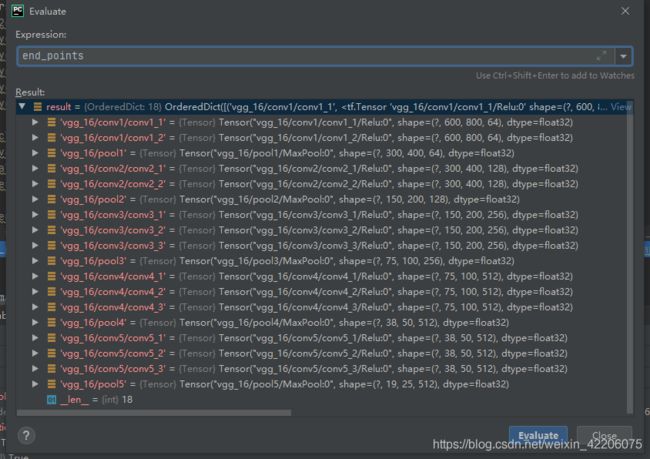Tensorflow---Faster RCNN网络(细节,代码部分函数)(五)
Tensorflow—Faster RCNN网络(细节,代码部分函数)(五)
经过了四个blog的介绍,Faster RCNN网络也基本上讲完了,但是里面还有一些细节没有扣明白,这明显就不符合本人的作风啊~所以特地抽出一篇blog来介绍下内部一些难懂的点。
值得注意的,这篇blog的内容大部分是通过在网上自己搜索出来的答案,最后加上自己的理解才写上去的,所以若有错误的地方,还请大佬们指正~
一、utils.convert_collection_to_dict
'''
在原文中的位置:Faster_RCNN_TensorFlow-master\rpn_proposal\vggnet.py(vgg16函数)
'''
with variable_scope.variable_scope(scope, 'vgg_16', [inputs]) as sc:
end_points_collection = sc.original_name_scope + '_end_points'
# Collect outputs for conv2d, fully_connected and max_pool2d.
with arg_scope(
[layers.conv2d, layers_lib.fully_connected, layers_lib.max_pool2d],
outputs_collections=end_points_collection):
...........
# Convert end_points_collection into a end_point dict.
end_points = utils.convert_collection_to_dict(end_points_collection)
**解释:**slim.utils.convert_collection_to_dic把with作用域下面的计算结果,都汇总到一个list中,每个成员是一个tuple,包括每层网络的名字,每一层的输出结果,形状,数据类型

二、tf.nn.embedding_lookup
'''
在原文中的位置:Faster_RCNN_TensorFlow-master\step1_train_rpn.py
'''
cls_logits = tf.concat([tf.nn.embedding_lookup(cls[i], bbox_indxs[i])[tf.newaxis] for i in range(BATCHSIZE)], axis=0) #shape=(1, 256, 2)
reg_logits = tf.concat([tf.nn.embedding_lookup(reg[i], bbox_indxs[i])[tf.newaxis] for i in range(BATCHSIZE)], axis=0) #shape=(1, 256, 4)
**解释:**主要是选取一个张量里面指定索引对应的元素
import tensorflow as tf
import numpy as np
n_a = np.random.random([5,1])
a = tf.constant(value=n_a, dtype=tf.float32, shape=[5,1], name="Const")
res = tf.nn.embedding_lookup(
params=a, #需要筛选的张量
ids=[0,1], #指定的索引
partition_strategy="mod",
name=None,
validate_indices=True, # pylint: disable=unused-argument
max_norm=None
)
sess = tf.InteractiveSession()
print(sess.run(a))
print('*'*50)
print(sess.run(res))
效果:
[[0.8681717 ]
[0.04858067]
[0.01002295]
[0.09027253]
[0.71396136]]
**************************************************
[[0.8681717 ]
[0.04858067]]
三、tf.add_n([tf.nn.l2_loss(var) for var in tf.trainable_variables()])
'''
在原文中的位置:Faster_RCNN_TensorFlow-master\step1_train_rpn.py
'''
regular = tf.add_n([tf.nn.l2_loss(var) for var in tf.trainable_variables()])
解释:遍历trainable variables添加L2正则化项,步骤:
1.遍历可训练参数,将每个参数传入tf.nn.l2_loss()进行计算并相加起来;
2.乘以weight_decay并与base_loss相加。
weight_decay = 0.001
base_loss = tf.reduce_mean(tf.nn.sparse_softmax_cross_entropy_with_logits(labels=labels, logits=logits))
l2_loss = weight_decay * tf.add_n([tf.nn.l2_loss(tf.cast(v, tf.float32)) for v in tf.trainable_variables()])
loss = base_loss + l2_loss
注意:该过程对每个trainable variable都进行了l2正则化,包括权值w和偏置b。有种说法是如果对偏执b进行l2正则化将会导致欠拟合,一般只需要对权值w进行正则化。
tf.add_n([p1, p2, p3…])函数是实现一个列表的元素的相加。就是输入的对象是一个列表,列表里的元素可以是向量,矩阵等
四、np.union1d与np.setdiff1d
'''
在原文中的位置:Faster_RCNN_TensorFlow-master\rpn_proposal\utils.py(generate_minibatch函数)
'''
illegal_idx0 = np.union1d(np.where(anchors_x1<0)[0], np.where(anchors_x2>=IMG_W)[0]) # (6612,)
illegal_idx1 = np.union1d(np.where(anchors_y1<0)[0], np.where(anchors_y2>=IMG_H)[0]) # (8500,)
illegal_idx = np.union1d(illegal_idx0, illegal_idx1) # (11204,),即17100个框中有11204个框的xy超过了图片本身
# np.setdiff1d:找到2个数组中集合元素的差异,返回值:在ar1中但不在ar2中的已排序的唯一值。
legal_idx = np.setdiff1d(np.array(range(nums)), illegal_idx)
解释:
1.np.union1d:找到两个array数组的并集
2.np.setdiff1d:找到2个数组中集合元素的差异,返回值:在ar1中但不在ar2中的已排序的唯一值。
np.union1d([-1, 0, 1], [-2, 0, 2])
结果:
array([-2, -1, 0, 1, 2])
------------------------------------------------------
a = np.array([1, 2, 3, 4, 5, 6, 7, 8, 9])
b = np.array([3, 4, 7, 6, 7, 8, 11, 12, 14])
c = np.setdiff1d(a,b)
结果:
array([1, 2, 5, 9])
五、tf.image.non_max_suppression
'''
在原文中的位置:step1_train_rpn.py
'''
cls, reg = cls[0], reg[0] #shape=(17100, 2),shape=(17100, 4)
scores = tf.nn.softmax(cls)[:, 1] #shape=(17100,),计算 17100个anchor box属于前景的概率
anchors = tf.constant(anchors, dtype=tf.float32) #shape=(17100, 4)
normal_bbox, reverse_bbox = offset2bbox(reg, anchors) # reverse_bbox:[y0, x0, y1, x1]; normal_bbox:[x0, y0, x1, y1],shape=(17100,4)
nms_idxs = tf.image.non_max_suppression(reverse_bbox, scores, max_output_size=2000, iou_threshold=NMS_THRESHOLD) # 非极大值抑制NMS-tf实现api
解释:
tf.image.non_max_suppression(
reverse_bbox, #待进行nms操作的tensor对象(shape一般为(bbox_num,4),其中4表示的是(y1,x1,y2,x2),这也就解释了为啥传入的是reverse_bbox,而不是normal_bbox)
scores, #shape为(bbox_num,),表示的是上面的每个bbox对应的score
max_output_size=2000, #最后进行筛选出来的框数量
iou_threshold=NMS_THRESHOLD) #表示判断框是否与IOU重叠过多的阈值
返回:形状[M]的一维整数张量,表示从box张量中选择的框下标,其中M <= max_output_size。
举个例子吧
import tensorflow as tf
import numpy as np
bboxes = tf.constant(value=[[1,2,3,4],[2,3,1,4],[2,4,3,1],[2,3,4,5]],
dtype=tf.float32)
score = tf.constant(value=[0.7,0.8,0.4,0.6],dtype=tf.float32)
sess = tf.InteractiveSession()
idx = sess.run(tf.image.non_max_suppression(boxes=a,
scores=b,
max_output_size=3,
iou_threshold=0.5,))
re = tf.nn.embedding_lookup(params=a,
ids=idx,
partition_strategy="mod")
print(idx)
print('-'*80)
print(sess.run(re))
效果:
[1 0 3]
--------------------------------------------------------------------------------
[[2. 3. 1. 4.]
[1. 2. 3. 4.]
[2. 3. 4. 5.]]
六、tf.image.crop_and_resize
'''
在原文中的位置:Faster_RCNN_TensorFlow-master\fast_rcnn\ops.py(roi_pooling函数)
'''
inputs = tf.image.crop_and_resize(inputs, boxes, box_idx, [POOLED_H, POOLED_W])
解释:
这个函数其实就是tf中进行ROI pooling的api,
tf.image.crop_and_resize(
inputs, #输入的图片
boxes, #图片中待进行roi的proposal
box_idx, #boxes和image之间的索引,假如这里的inputs两张图片,那么这个参数就要在这两张图片里面选择了
crop_size,#裁剪尺寸)
七、tf.squeeze
'''在原文中的位置:Faster_RCNN_TensorFlow-master\fast_rcnn\vggnet.py'''
net = tf.squeeze(net, axis=[1, 2])
**解释:**这个函数的作用是删除tensor中维度为1的维度,类似于扁平化操作。
在这个代码中,经过了最后一层的全卷积之后的tensor的shape为(64,1,1,4096),经过了tf.squeeze之后shape变成了(64,4096),目的是因为在这里的代码是进行全卷积操作,而论文中是进行全连接操作,全连接最后会直接得到(64,4096),但是全卷积得到的却是(64,1,1,4096)。